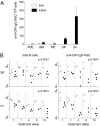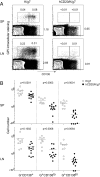Rituximab specifically depletes short-lived autoreactive plasma cells in a mouse model of inflammatory arthritis
- PMID: 20176942
- PMCID: PMC2842072
- DOI: 10.1073/pnas.1001074107
Rituximab specifically depletes short-lived autoreactive plasma cells in a mouse model of inflammatory arthritis
Abstract
There is increasing appreciation of the important role of B cells in many autoimmune diseases and consequently, increasing interest in treating these disorders through B cell-depletion therapy with rituximab, an anti-CD20 monoclonal antibody. Yet, precisely how this and related drugs exert their therapeutic effects remains controversial. In particular, it is unclear how, in a number of contexts, rituximab can greatly reduce the titer of serum autoantibodies without substantially altering the overall antibody titer. We have studied the action of this drug in the K/BxN mouse model of inflammatory arthritis after first crossing in a human CD20 transgene. Rituximab treatment of these mice led to a decrease in the titer of serum antibodies targeting glucose-6-phosphate isomerase, the relevant autoantigen, but not in the total antibody titer. Glucose-6-phosphate isomerase-specific plasma cells did not reside primarily in the bone marrow as expected but rather in the spleen and lymph nodes, where they had short lives, expressed CD20, and were rapidly depleted by rituximab. These data support a model whereby autoreactive plasma cells (at least certain specificities thereof) are intrinsically different from protective antimicrobial plasma cells in their differentiation, migration, and survival properties. Rituximab targets the former and spares the latter.
Conflict of interest statement
The authors declare no conflict of interest.
Figures







Comment in
-
Rituximab targets short-lived autoreactive plasmablasts.Nat Rev Rheumatol. 2010 May;6(5):246. doi: 10.1038/nrrheum.2010.53. Nat Rev Rheumatol. 2010. PMID: 20440898 No abstract available.
References
-
- Martin F, Chan AC. B cell immunobiology in disease: Evolving concepts from the clinic. Annu Rev Immunol. 2006;24:467–496. - PubMed
-
- Hoyer BF, Manz RA, Radbruch A, Hiepe F. Long-lived plasma cells and their contribution to autoimmunity. Ann N Y Acad Sci. 2005;1050:124–133. - PubMed
-
- Radbruch A, et al. Competence and competition: The challenge of becoming a long-lived plasma cell. Nat Rev Immunol. 2006;6:741–750. - PubMed
Publication types
MeSH terms
Substances
Grants and funding
LinkOut - more resources
Full Text Sources
Other Literature Sources
Medical

